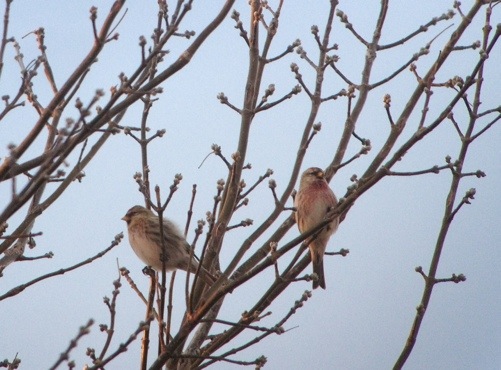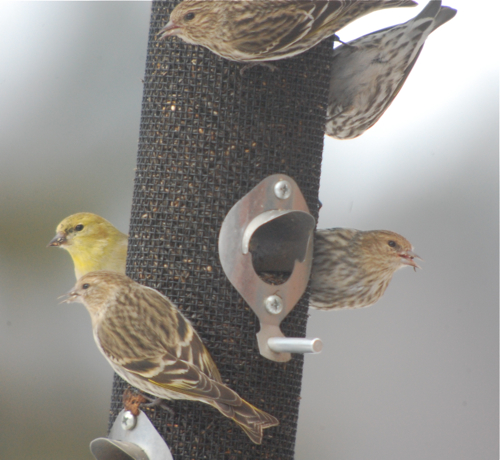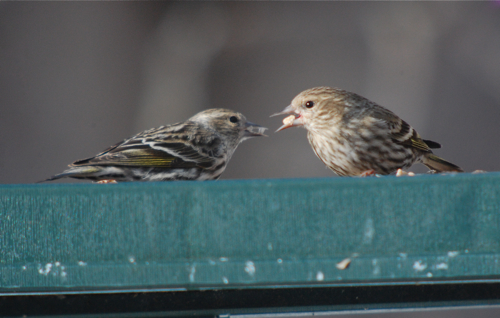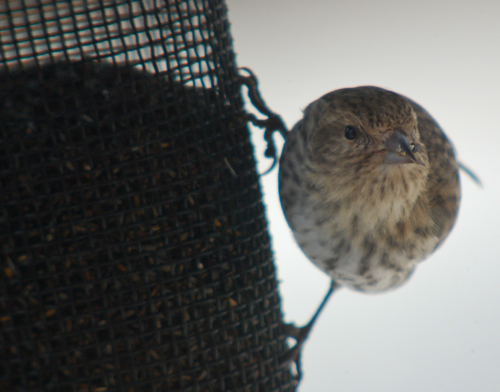 Sunday was a much needed day--take in that common redpoll! At Thursday's Birds and Beer, people were talking about the Sax Zim Bog festival and Ecobirder was talking about his photos from the bog. (by the way, did you see his eagle release entry--very cool). My friend Amber was there and having been so sick and seeing the mountain of catch up work that I had coming, I desperately wanted a day in the bog. I had led a field trip there this year, but I just needed a day of just worrying about showing myself birds. I said, "Hey, Amber, do you want to do a day trip to the bog on Sunday?" There was only one answer to that question.
Sunday was a much needed day--take in that common redpoll! At Thursday's Birds and Beer, people were talking about the Sax Zim Bog festival and Ecobirder was talking about his photos from the bog. (by the way, did you see his eagle release entry--very cool). My friend Amber was there and having been so sick and seeing the mountain of catch up work that I had coming, I desperately wanted a day in the bog. I had led a field trip there this year, but I just needed a day of just worrying about showing myself birds. I said, "Hey, Amber, do you want to do a day trip to the bog on Sunday?" There was only one answer to that question.
 And away we went! It was a blast. We used to bird quite a bit, but careers have changed our schedules and it had been awhile since it was just the two of us hanging out and birding. We ended up spending a good portion of the day talking in I Can Haz Cheezburger language--which will probably seep its way into this blog entry. Our first stop was at a residential feeding station open to the public on Blue Spruce Rd, about a mile north of 133. Someone asked in an earlier comment what the redpolls are eating. This is a mixture if Nyjer (thistle) and finely ground sunflower chips. There were also eating black oil sunflower seeds.
And away we went! It was a blast. We used to bird quite a bit, but careers have changed our schedules and it had been awhile since it was just the two of us hanging out and birding. We ended up spending a good portion of the day talking in I Can Haz Cheezburger language--which will probably seep its way into this blog entry. Our first stop was at a residential feeding station open to the public on Blue Spruce Rd, about a mile north of 133. Someone asked in an earlier comment what the redpolls are eating. This is a mixture if Nyjer (thistle) and finely ground sunflower chips. There were also eating black oil sunflower seeds.
 The pine grosbeaks were still hanging around. As we were getting photos a huge flock of evening grosbeaks flew overhead and landed in the surrounding trees--we froze, excited at the possibility of getting photos. But they chirped for about five minutes and flew away! We got totally rejected by evening grosbeaks. Jerks.
The pine grosbeaks were still hanging around. As we were getting photos a huge flock of evening grosbeaks flew overhead and landed in the surrounding trees--we froze, excited at the possibility of getting photos. But they chirped for about five minutes and flew away! We got totally rejected by evening grosbeaks. Jerks.
 But the pine grosbeaks more than made up for the evening grosbeak dis. Look at those fluffy feathers under the chin--I could get lost in those pink floofy bits.
But the pine grosbeaks more than made up for the evening grosbeak dis. Look at those fluffy feathers under the chin--I could get lost in those pink floofy bits.
 We just kept getting great bird after great bird at this feeding station. Some gray jays flew into the feeders as did some downy and hairy woodpeckers. And then a boreal chickadee flew in. That used to be a challenging bird to get in the bog--let alone get a photo. I aimed my digiscoping setup and prepared to get the best (and only) photo of a boreal chickadee I'd ever gotten in my entire life:
We just kept getting great bird after great bird at this feeding station. Some gray jays flew into the feeders as did some downy and hairy woodpeckers. And then a boreal chickadee flew in. That used to be a challenging bird to get in the bog--let alone get a photo. I aimed my digiscoping setup and prepared to get the best (and only) photo of a boreal chickadee I'd ever gotten in my entire life:
 Even with a feeder, this is still a challenging bird to photograph. I could bore you with the twenty some odd photos I have of its butt, however, I did manage one photo of its head:
Even with a feeder, this is still a challenging bird to photograph. I could bore you with the twenty some odd photos I have of its butt, however, I did manage one photo of its head:
 Digiscopin' Skillz - I has dem! This is just the best fun to me! I love living where I do. I love how I have great birds in my own neighborhood, but just a day trip away is completely different habitat with completely different feeder birds. I love how the community at Sax Zim, with the help of local birders and photographers has found away for people like me to safely enjoy the birds without irritating the crap out of them. What a treat to be able to stand in someone's driveway for awhile and just watch some of the coolest birds in the bog. This beats a few years ago with me stopping along the road watching for flocks of chickadees and pishing them out.
Digiscopin' Skillz - I has dem! This is just the best fun to me! I love living where I do. I love how I have great birds in my own neighborhood, but just a day trip away is completely different habitat with completely different feeder birds. I love how the community at Sax Zim, with the help of local birders and photographers has found away for people like me to safely enjoy the birds without irritating the crap out of them. What a treat to be able to stand in someone's driveway for awhile and just watch some of the coolest birds in the bog. This beats a few years ago with me stopping along the road watching for flocks of chickadees and pishing them out.
 We drove around the bog a bit and headed to the deer ribs hanging in the tree on Admiral Rd. That had been a good spot for woodpeckers and jays this winter. The tree had changed a great deal in the weeks since I visited. Last time I was there, it was just one deer torso and now had become some strange looking bird feeding altar. It now had a deer rib cage, some store bought suet with a butt load of bird seed on the ground. It looked like some crap mix full of milo and then some all purpose mix with sunflowers. If you look at the ground in the above photo, you can see that I set the Wingscapes Camera in the seed.
We drove around the bog a bit and headed to the deer ribs hanging in the tree on Admiral Rd. That had been a good spot for woodpeckers and jays this winter. The tree had changed a great deal in the weeks since I visited. Last time I was there, it was just one deer torso and now had become some strange looking bird feeding altar. It now had a deer rib cage, some store bought suet with a butt load of bird seed on the ground. It looked like some crap mix full of milo and then some all purpose mix with sunflowers. If you look at the ground in the above photo, you can see that I set the Wingscapes Camera in the seed.
 I did get some redpoll photos. I'm not sure if all that seed is a good idea, I'm not sure who is leaving it, maybe just visiting birders and photographers. It's fun to see the redpolls there too, however that much seed on the ground in melting snow mixed with a few hundred redpolls is the makings of a salmonella outbreak. There were also about three dozen black-capped chickadees popping in and out for seed and suet.
I did get some redpoll photos. I'm not sure if all that seed is a good idea, I'm not sure who is leaving it, maybe just visiting birders and photographers. It's fun to see the redpolls there too, however that much seed on the ground in melting snow mixed with a few hundred redpolls is the makings of a salmonella outbreak. There were also about three dozen black-capped chickadees popping in and out for seed and suet.
 I love this photo. The redpoll looks like its gleaming the cube (yeah, I went there).
I love this photo. The redpoll looks like its gleaming the cube (yeah, I went there).
 Here's another boreal chickadee. It's interesting to note that the birds preferred the complete meaty deer torso over just the rib cage with the fat attached. It could be that they are just more used to the meaty torso and will turn to the rib cage as its there longer.
Here's another boreal chickadee. It's interesting to note that the birds preferred the complete meaty deer torso over just the rib cage with the fat attached. It could be that they are just more used to the meaty torso and will turn to the rib cage as its there longer.
 Here's another back shot of the boreal chickadee. Look at that faded brown cap where a black-capped would be black. What a fun, different little bird. The fun thing about digiscoping is that these birds move so fast that you don't always get to appreciate all the little details of these birds. Just fun to sit at home and just look at all his little plumage differences.
Here's another back shot of the boreal chickadee. Look at that faded brown cap where a black-capped would be black. What a fun, different little bird. The fun thing about digiscoping is that these birds move so fast that you don't always get to appreciate all the little details of these birds. Just fun to sit at home and just look at all his little plumage differences.
 We did have one freaky instance up there and really, a trip to the bog isn't complete without something weird happening--that's part of the charm of birding there. We didn't get photos of what happened, so I'm going to use some of my many redpoll photos to go along with it.
We did have one freaky instance up there and really, a trip to the bog isn't complete without something weird happening--that's part of the charm of birding there. We didn't get photos of what happened, so I'm going to use some of my many redpoll photos to go along with it.
 We drove back to the Blue Spruce feeding station. Blue Spruce is one of those roads that curves around a few times, changes names and then dumps back out onto 133. We were creeping along Blue Spruce looking for black-backed and three-toed woodpeckers and then just kind of kept going on the off chance we could see anything else on the back roads. When we got to the end of Aspen, where it curves and changes into Birch we could see about six large dogs shoulder to shoulder in the road. I've seen a couple of dogs on this road before but not this many. I slowed down because the road was icy and figured if I drove through slowly, the dogs would part and we could get through. The dogs didn't move, in fact, they charged the car and started barking.
We drove back to the Blue Spruce feeding station. Blue Spruce is one of those roads that curves around a few times, changes names and then dumps back out onto 133. We were creeping along Blue Spruce looking for black-backed and three-toed woodpeckers and then just kind of kept going on the off chance we could see anything else on the back roads. When we got to the end of Aspen, where it curves and changes into Birch we could see about six large dogs shoulder to shoulder in the road. I've seen a couple of dogs on this road before but not this many. I slowed down because the road was icy and figured if I drove through slowly, the dogs would part and we could get through. The dogs didn't move, in fact, they charged the car and started barking.
We couldn't get through and stopped. I tried honking but that didn't do anything. I tried to creep forward and they would just run around on all sides and wouldn't let us through. I honestly didn't know how to get around them without hitting one.
 Eventually, a woman came out and tried to call them in, but it did no good. She came over to the car and it explained that the dogs get dumped here. She said that at one point someone had dumped 50 some odd huskies at this corner. These dogs didn't look like huskies, more like some type of boxer. As she was talking to us, the dogs were jumping and bouncing off my car--they were jumping to the top of the window and we could see more dogs coming out of the woods. We could also see in her truck off the side that there were at least three more smaller dogs inside. All the dogs looked well fed and I was grateful I was at least driving down the road and not walking.
Eventually, a woman came out and tried to call them in, but it did no good. She came over to the car and it explained that the dogs get dumped here. She said that at one point someone had dumped 50 some odd huskies at this corner. These dogs didn't look like huskies, more like some type of boxer. As she was talking to us, the dogs were jumping and bouncing off my car--they were jumping to the top of the window and we could see more dogs coming out of the woods. We could also see in her truck off the side that there were at least three more smaller dogs inside. All the dogs looked well fed and I was grateful I was at least driving down the road and not walking.
 I told her that I didn't know how to get through without hitting one and she said if I went fast, the dogs would part ways. She said that they just want to race the car and if I hit one, it was no big deal. No big deal to her, but a big deal to me.
I told her that I didn't know how to get through without hitting one and she said if I went fast, the dogs would part ways. She said that they just want to race the car and if I hit one, it was no big deal. No big deal to her, but a big deal to me.
We pulled ahead and the pack followed us, still surrounding the car. Some kept running and stopping in front of the car and others continued to jump up to the side--one jumped up, I heard a bump and then yelping. They followed us around the corner for about a quarter of mile running in front of the car as soon as we would try to speed up seemingly aware that we would stop to not hit them. There were just so many coming from so many different directions that I was really in a panic that I would hit one or run it over. Amber was great with the encouragement and helping to keep me calm. I don't remember exactly what we said to each other, but I'm fairly certain it involved lost of words starting with the letter F. I don't know how I would have made it alone. Doggies, don't eatz meh car plz, ok, thx, bye.
 We eventually made it through, but it was incredibly unnerving, the dogs seem to sense that you don't want to hit them and just run in front of you and bite your bumper. When I got home last night, I posted the experience on the Minnesota listservs and got six emails right away from people who had a similar experience and weren't sure about posting. About half of them told me that they also saw a 400 - 500 pound pig mixed in with the dogs!
We eventually made it through, but it was incredibly unnerving, the dogs seem to sense that you don't want to hit them and just run in front of you and bite your bumper. When I got home last night, I posted the experience on the Minnesota listservs and got six emails right away from people who had a similar experience and weren't sure about posting. About half of them told me that they also saw a 400 - 500 pound pig mixed in with the dogs!
Mike Hendrickson has been great about sending our experiences to local city officials and trying to contact animal shelters up there to maybe do something about the dogs. The mayor advised that if you have this experience that you call 911--stress that it's not an emergency, but describe the incident and where it's happening. The more calls, the more likely something can be done to control the dogs.
 After our experience, I told Amber that I had to go back to the bird feeders and soak up some cleansing redpoll action. We soaked up the redpolls, cleansed ourselves of the scary not so lol dogs and headed back to the Twin Cities.
After our experience, I told Amber that I had to go back to the bird feeders and soak up some cleansing redpoll action. We soaked up the redpolls, cleansed ourselves of the scary not so lol dogs and headed back to the Twin Cities.
Another great day in the bog.



 I was out at
I was out at 






